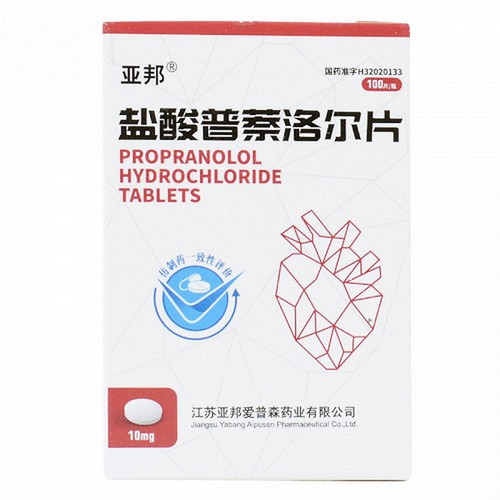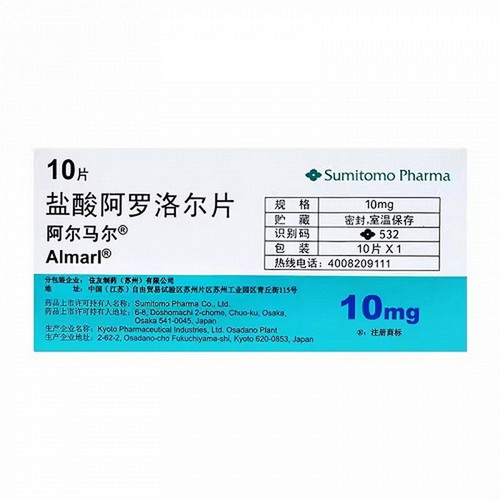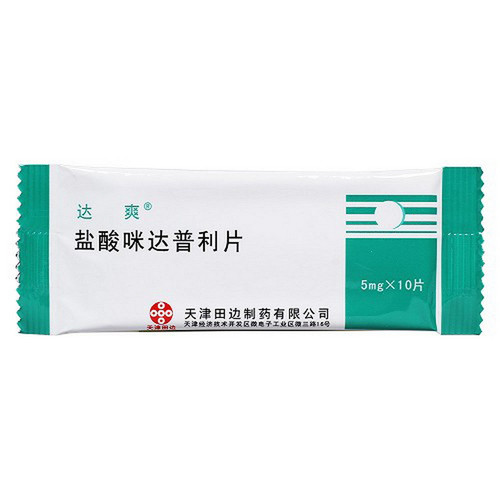Product Overview
[Drug Name]
Generic Name: Propranolol Hydrochloride Sustained-Release Tablets
Trade Name: Pulexin
English Name: Propranolol Hydrochloride Sustained-Release Tablets
Chinese Pinyin: Yansuan Punailuoer Huanshi Pian
[Ingredients]
The main ingredient and chemical name of this product is: 1-isopropylamino-3-(1-naphthyloxy)-2-propanol hydrochloride.
[Properties]
This product is a white tablet.
[Indications]
1. Hypertension (alone or in combination with other antihypertensive drugs). 2. Exertional angina. 3. Control of supraventricular tachyarrhythmias and ventricular arrhythmias, particularly those related to catecholamines or caused by digitalis. It can be used to control the ventricular rate in atrial flutter and atrial fibrillation where digitalis is ineffective. It can also be used to improve the patient's symptoms of refractory premature beats. 4. Reduces the outflow tract pressure gradient in hypertrophic cardiomyopathy, alleviating symptoms such as angina, palpitations, and syncope. 5. Used in combination with alpha-blockers to control tachycardia in patients with pheochromocytoma. 6. Used to control rapid heart rate in hyperthyroidism and can also be used to treat thyroid storm. 7. Used as secondary prevention to reduce mortality from myocardial infarction.
[Dosage and Administration]
1. Hypertension: Oral, initial dose 10 mg 3-4 times daily. Can be used alone or in combination with a diuretic. The dose should be gradually increased to a maximum daily dose of 200 mg.
2. Angina: Initially 5-10 mg 3-4 times daily; increase by 10-20 mg every 3 days, gradually increasing to 200 mg daily, in divided doses.
3. Arrhythmias: 10-30 mg 3-4 times daily. Take before meals and at bedtime.
4. Myocardial infarction: 30-240 mg 2-3 times daily.
5. Hypertrophic cardiomyopathy: 10-20 mg 3-4 times daily. Adjust the dose as needed and tolerated.
6. Pheochromocytoma: 10-20 mg, 3-4 times daily. Use for three days before surgery. Beta-blockers should generally be started first, followed by propranolol after the drug's efficacy stabilizes.
[Adverse Reactions]
This product may cause central nervous system adverse reactions such as dizziness, confusion (especially in the elderly), depression, and slowed reaction times; dizziness (caused by hypotension); bradycardia (<50 beats/minute); less common bronchospasm and dyspnea, congestive heart failure; and even more rare fever and sore throat (agranulocytosis), rash (allergic reaction), and bleeding tendency (thrombocytopenia). If adverse reactions persist, be especially vigilant for Raynaud's sign (cold extremities), diarrhea, fatigue, dry eyes, mouth, or skin, nausea, numbness in the fingers and toes, and unusual fatigue.
[Contraindications]
1. Bronchial asthma. 2. Cardiogenic shock. 3. Heart block (II-III degree atrioventricular block). 4 Severe or acute heart failure. 5 Sinus bradycardia.
[Precautions]
1 This drug can be taken orally on an empty stomach or with food; the latter may slow hepatic metabolism and increase bioavailability. 2 Tolerance to beta-blockers varies greatly from person to person, so dosing must be individualized. When first using this drug, start with a low dose, gradually increase the dose, and closely monitor the response to avoid unexpected events. 3 Note that blood concentrations of this drug do not fully predict pharmacological effects; therefore, clinical use should be guided by clinical findings such as heart rate and blood pressure. 4 Patients with coronary artery disease should not stop taking this drug abruptly, as this may cause angina pectoris, myocardial infarction, or ventricular tachycardia. 5 Patients with hyperthyroidism should also not stop taking this drug abruptly, as this may worsen hyperthyroidism symptoms. 6 Long-term users of this drug should withdraw the drug gradually, tapering the dose over at least three days, usually two weeks. 7. Long-term use of this drug may cause heart failure in a small number of patients. If this occurs, it can be corrected with digitalis glycosides and/or diuretics, followed by a gradual reduction in dosage and eventual discontinuation. 8. This drug may cause hypoglycemia in diabetic patients, but has no hypoglycemic effect in non-diabetic patients. Therefore, diabetic patients should have their blood sugar checked regularly. 9. Blood tests, blood pressure, heart function, liver and kidney function, etc. should be checked regularly while taking this drug. 10. Interference with diagnosis: When taking this drug, blood urea nitrogen, lipoproteins, creatinine, potassium, triglycerides, uric acid, etc. may increase, while blood sugar decreases. However, blood sugar may sometimes increase in diabetic patients. In patients with renal insufficiency, the metabolites of this drug may accumulate in the blood, interfering with the diazo reaction in serum bilirubin determinations, resulting in false positives. 11. Use this drug with caution in the following conditions: a history of allergies, congestive heart failure, diabetes, emphysema or non-allergic bronchial asthma, hepatic insufficiency, hypothyroidism, Raynaud's syndrome or other peripheral vascular disease, or renal failure.
[Use in Special Populations]
Precautions for Children:
The dosage has not yet been determined. Generally, the daily dose is 0.5-1.0 mg/kg body weight, taken orally in divided doses. The therapeutic range for blood concentrations in children based on body weight is similar to that in adults. However, the therapeutic range for blood concentrations in children based on body surface area is higher than that in adults. There are reports that blood concentrations are elevated in patients with congenital idiocy, thereby increasing bioavailability.
Precautions for Pregnancy and Lactation:
This drug can cross the placenta and enter the fetus. There are reports that use in women with gestational hypertension can cause intrauterine growth retardation, labor weakness leading to dystocia, and hypotension, hypoglycemia, respiratory depression, and a slow heart rate in newborns. Although there are reports of no effects on either the mother or the fetus, it should be used with caution and should not be used as a first-line treatment in pregnant women. This drug is secreted in small amounts in breast milk; therefore, it should be used with caution in lactating women.
Precautions for Elderly Patients:
Due to the reduced ability of elderly patients to metabolize and excrete drugs, the dosage should be adjusted appropriately.
[Drug Interactions]
1. Interactions with Antihypertensive Drugs: Combination use of this product with reserpine may cause orthostatic hypotension, bradycardia, dizziness, and syncope. Combination use with monoamine oxidase inhibitors may cause extreme hypotension. 2. Combination use with digitalis may cause atrioventricular block and slow heart rate, requiring close observation. 3. Combination use with calcium channel blockers, especially intravenous verapamil, may result in myocardial and conduction system depression. 4. Combination use with epinephrine, phenylephrine, or sympathomimetic amines may cause significant hypertension, bradycardia, and atrioventricular block. 5. Combination use with isoproterenol or xanthines may reduce the efficacy of the latter. 6. Combination use with haloperidol may cause hypotension and cardiac arrest. 7. Combination use with aluminum hydroxide gel may reduce the intestinal absorption of propranolol. 8. Alcohol may slow the absorption rate of this product. 9. Concomitant use with phenytoin, phenobarbital, and rifampicin may accelerate the elimination of this drug. 10. Concomitant use with chlorpromazine may increase the plasma concentrations of both drugs. 11. Concomitant use with antipyrine, theophylline, and lidocaine may reduce the clearance of this drug. 12. Concomitant use with thyroxine may result in decreased T3 concentrations. 13. Concomitant use with cimetidine may reduce the hepatic metabolism of this drug, delay its elimination, and increase the plasma concentration of propranolol. 14. This may affect blood glucose levels; therefore, when used concomitantly with antidiabetic drugs, the latter's dosage may require adjustment.
[Pharmacological Actions]
Pharmacological Actions: 1. Propranolol is a nonselective competitive inhibitor of adrenergic beta-receptor antagonists. It blocks beta-1 and beta-2 receptors on the heart, antagonizing sympathetic nerve excitation and the effects of catecholamines, reducing cardiac contractility and contraction velocity. It also inhibits vascular smooth muscle contraction, reducing myocardial oxygen consumption, and restoring the oxygen supply and demand balance of ischemic myocardium to a low level. It is used to treat angina pectoris. It inhibits adrenergic stimulation of cardiac pacemaker potentials and is used to treat arrhythmias. It can also inhibit renin release and reduce cardiac output through central and adrenergic neuronal blockade, making it useful for the treatment of hypertension. It competitively antagonizes the effects of isoproterenol and norepinephrine, blocking beta-2 receptors and reducing plasma renin activity. It can cause bronchospasm. It inhibits insulin secretion, raising blood sugar, masking symptoms of hypoglycemia, and delaying recovery from hypoglycemia. It has a significant antiplatelet aggregation effect, primarily related to its membrane stabilizing effects and inhibition of platelet membrane Ca+ transport. Carcinogenicity, Mutagenicity, and Reproductive Toxicity: Daily administration of 150 mg/kg to rats or mice for 18 months revealed no significant toxic effects, nor any drug-related carcinogenic effects. Reproductive studies revealed no impairment of reproductive capacity related to propranolol. This product exhibited embryotoxicity when administered to animals at 10 times the human dose.
Storage: Store in sealed containers.
Specifications: 40 mg
Packaging: 40 mg x 10s/box
Expiration Date: 36 months
Approval Number: National Medicine Standard H10970353
Manufacturer: Yantai Luyin Pharmaceutical Co., Ltd.







